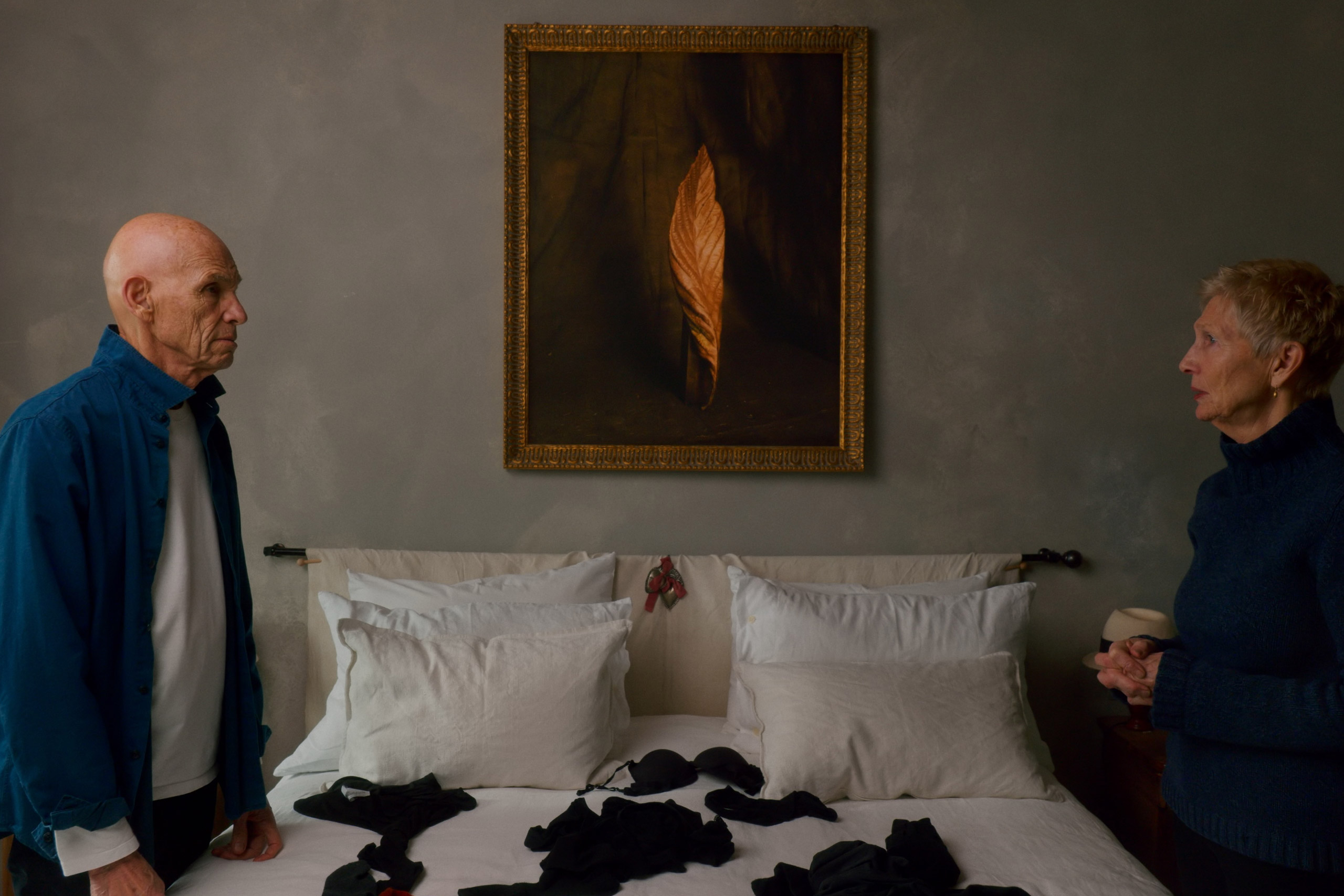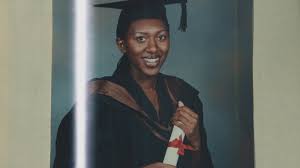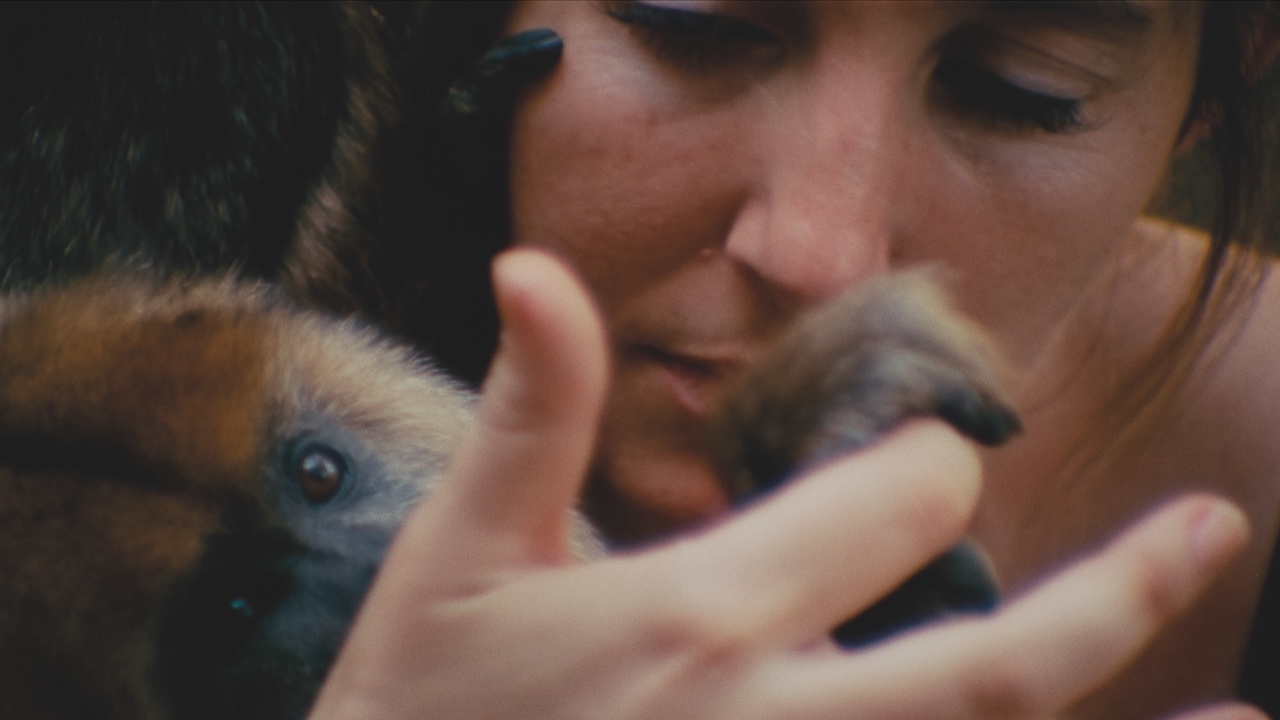Documentary highlights from the 2024 London Film Festival | reviews, news & interviews
Documentary highlights from the 2024 London Film Festival
Documentary highlights from the 2024 London Film Festival
A close look at insightful new non-fiction films about single motherhood, visionary photographers, scam artists, legacies of colonialism, and more

One of the many pleasures of the London Film Festival is the chance to see high-quality documentaries on the big screen. If lucky, these films might get a brief, specialist cinema release, but all too often non-fiction features are destined for TV. Seeing them projected full-size in the dark with a live audience sharing the experience is a far better way of gauging their impact than watching them alone in a living room.
Victoria Mapplebeck’s Motherboard (pictured above) got the warmest reception: its sold-out screenings were greeted with laughter and a standing ovation. It’s a tender, exhilarating exploration of parenting through cancer, COVID, and teenage angst, with star performances by the mother and son leads. A freelance British TV director, Mapplebeck had been making a decent living making factual documentaries for UK broadcasters when she found herself unintentionally pregnant after just four dates with a new man.
It rapidly became clear that he didn’t want to be involved and was leaving the country. Raising a child solo isn’t remotely compatible with freelance film-making with its erratic pay and long hours, so Mapplebeck gave up the shooting and directing work that she loved and took a job in academia with a steady income and a fixed calendar.
But Mapplebeck never put her camera down. She filmed her son, Jim, from his very first appearance on an ultrasound screen through childhood, adolescence, and on to the end of school. The result is an intimate rollercoaster ride that’s reminiscent both of Richard Linklater’s Boyhood and Michael Apted’s seminal Up series. We get to know Jim as a funny, curious toddler making up songs for his mum and watch him turn into a troubled teenager grappling with how he feels about meeting his father for the first time. Meanwhile, Mapplebeck deals with gruelling breast cancer treatment and the icy fear of not living long enough to see her son into adulthood.
Motherboard is not only an endearing portrayal of solo parenting over 20 years, it’s also highly impressive technically, as it’s been filmed almost entirely on iPhones with no loss of quality either in image or sound. Due out next year in time for Mother’s Day, it’s well worth catching.
Two other powerful documentaries in the festival also focused on protagonists who frame their worlds through a camera. The South African photographer Ernest Cole grew up in a township near Pretoria under the apartheid regime. He went into exile in the US when the publication by Magnum of his ground-breaking book of life under segregation, House of Bondage, was banned in his homeland.
Although Cole was given a grant in the US for another book about life among impoverished rural and urban African-Americans, it was never published and he moved to Sweden, where he took up filmmaking before dying at the age of 49 in 1990. While his South African work had featured in ANC histories and campaigns, his other images had been forgotten.
The veteran Haitian filmmaker Raoul Peck weaves together a compelling narrative in Ernest Cole: Lost and Found, drawing on a collection of 60,000 of Cole's negatives that were discovered in a vault in Stockholm in 2018. Eschewing a conventional journalistic commentary or interviews with experts, the film tells Cole’s extraordinary life story with a first-person voice-over stitched together from Cole’s writings and recorded interviews. This narration is delivered dispassionately – but very effectively – by the actor Lakeith Stanfield.
Peck’s film is a gripping portrait of a great observational photographer who was unappreciated in his lifetime. It's also a reminder of the way racism operated not only in apartheid-era South Africa, but America, too. Cole couldn’t get photojournalism assignments there unless he stuck to a narrow remit of recording hardscrabble Black lives.
 Peck’s film stands in stark contrast with another documentary examination of a photographer’s life. Two Strangers Trying Not to Kill Each Other is the story of Joel Meyerowitz, acclaimed for his pioneering use of colour in the early Seventies when only black and white photography was taken seriously as an art form. Hugely successful gallery shows around the world and countless books followed. When the World Trade Centre was attacked in 2001, Meyerowitz was the only photographer allowed unrestricted access to Ground Zero in the immediate aftermath.
Peck’s film stands in stark contrast with another documentary examination of a photographer’s life. Two Strangers Trying Not to Kill Each Other is the story of Joel Meyerowitz, acclaimed for his pioneering use of colour in the early Seventies when only black and white photography was taken seriously as an art form. Hugely successful gallery shows around the world and countless books followed. When the World Trade Centre was attacked in 2001, Meyerowitz was the only photographer allowed unrestricted access to Ground Zero in the immediate aftermath.
Yet co-directors Jacob Perlmutter and Manon Ouimet are less interested in admiring Meyerowitz’s oeuvre than observing his marriage with Maggie Barnett, a frustrated artist (pictured above). We are given a rapid resumé of the couple’s colourful former lives (ex-spouses, assorted addictions, estranged children) before they met and fell in love in middle age. And while Meyerowitz is going strong at 84 (his dancing is particularly impressive), the equally svelte and graceful Barnett is pretty furious to find herself having to learn to walk again at 75 after a car accident.
Perlmutter and Ouimet (a couple in real life) seem to have embedded themselves in Meyerowitz and Barnett’s marriage to the point of being in their bedroom to film them when they wake up in the morning, recording every adoring conversation and loving glance. It all feels a bit contrived and suffocating as the couple moves from its beautiful home in the golden Tuscan hills back to New York.
The documentary is redeemed by one outstanding scene showing Barnett laying into Meyerowitz, and expressing all her rage at how her life and artistic identity have been subsumed and sidelined by his. Her paintings have never been taken seriously; her novel had to be self-published. The camera holds on Barnett as she harangues her husband, whose every attempt to redeem himself provokes more rage.
It’s not quite enough of a payoff and certainly doesn’t turn Two Strangers Trying Not to Kill Each Other into another Anatomy of a Fall, but it certainly helps make the doc more than just another artist’s hagiography.
Two new documentaries take a sympathetic look at people who could be described as con artists but prove more complex. Look into My Eyes is a slightly mannered series of vignettes observing seven New York psychics at work as they give readings to people desperate to know about their pasts or futures. Everyone is very serious and more than a little bit needy – the psychics long to be believed, their clients long to be enlightened.
Director Lana Wilson leaves it up to the audience to decide who is most deserving of our sympathies and has found some intriguing characters on both sides, but her self-effacing, overtly non-judgmental film is too long and sadly lacks the kind of big punchy scene that gives Two Strangers its climax.
 There’s no shortage of authorial energy in The Shadow Scholars, a British documentary that sees Professor Patricia Kingori (pictured left) investigating the global black market in essay-writing for cash. It’s a multi-billion industry whereby young, underemployed graduates from the global South – particularly Kenya – pump out essays, theses, and coursework to be sold online.
There’s no shortage of authorial energy in The Shadow Scholars, a British documentary that sees Professor Patricia Kingori (pictured left) investigating the global black market in essay-writing for cash. It’s a multi-billion industry whereby young, underemployed graduates from the global South – particularly Kenya – pump out essays, theses, and coursework to be sold online.
Students in the West are the main buyers. Kingori excoriates a system that enables those with money to game the system and go on to well-paid jobs with fraudulently earned qualifications while the real scholars languish in poverty. The essay-mill masterminds who run this global con pass on a fraction of the fees they charge.
The Shadow Scholars makes an insightful critique. Kingori is a dynamic presence and passionately argues that this exploitative industry is a legacy and perpetuation of colonialism. Unfortunately, the film is slightly marred by an overly emphatic music score and a few too many drone camera overhead shots used as screen-filler.
Two London Film Festival documentaries chose very different styles to explore Victorian-era institutions from a 21st century perspective. Collective Monologue is a beautifully made film that follows the transformation of Buenos Aires’ Palermo Zoo (built in 1888) into an Eco-Park after its closure in 2016. Anglo-Argentinian director Jessica Sarah Rimland spent five years shooting on 16mm film to create her meditative study (pictured below right). The 19th century zoo was reconfigured from a provider of spectacle for human visitors into an environment more suitable for the well-being of its animal inhabitants.
There’s no narration, and in lieu of a music track there's a subtle soundscape; the director clearly trusts the viewer to make the connections between past and present without overt editorialising. That trust pays off, resulting in a quietly contemplative film that raises questions about the complex legacies of colonialism and the history of spectacle – the city dwellers of Buenos Aires were mainly of European origin, and happy to gawp not only at elephants but also at Argentina’s original tribal people, who were put on display in enclosures.
 Holloway is a documentary about a different imprisoning institution, but one that isn't content just to observe. The film has been entirely engineered by its makers to make a case. Six women, who separately had served time in the North London prison were invited to come and spend time in the now derelict complex of buildings.
Holloway is a documentary about a different imprisoning institution, but one that isn't content just to observe. The film has been entirely engineered by its makers to make a case. Six women, who separately had served time in the North London prison were invited to come and spend time in the now derelict complex of buildings.
They sit in a circle with a mediator and are filmed recalling what led to their sentences and to share their memories of Holloway. Once the largest women’s prison in Europe, it’s now awaiting redevelopment. There are too many moody shots – accompanied by a moody score – of paint-peeling corridors, cells empty but for a bashed metal bed frame, and buddleia sprouting in courtyards, all of which serve to pad out the therapeutic encounter sessions between the former inmates.
Documentaries like Holloway stand or fall on the casting of their subjects, and while the film reflects the fact that nearly all the women who end up in the prison system have been victims of childhood abuse and neglect leading to addiction, mental illness, and criminality, it does mean that the six women’s stories overlap and repeat. There are some powerful emotional interactions between the former inmates, but they are not quite sufficient to get past the contrivance of the film’s set up.
- More films on theartsdesk
Explore topics
Share this article
The future of Arts Journalism
You can stop theartsdesk.com closing!
We urgently need financing to survive. Our fundraising drive has thus far raised £49,000 but we need to reach £100,000 or we will be forced to close. Please contribute here: https://gofund.me/c3f6033d
And if you can forward this information to anyone who might assist, we’d be grateful.

Subscribe to theartsdesk.com
Thank you for continuing to read our work on theartsdesk.com. For unlimited access to every article in its entirety, including our archive of more than 15,000 pieces, we're asking for £5 per month or £40 per year. We feel it's a very good deal, and hope you do too.
To take a subscription now simply click here.
And if you're looking for that extra gift for a friend or family member, why not treat them to a theartsdesk.com gift subscription?
more Film
 theartsdesk Q&A: Idris Elba on playing a US President faced with a missile crisis in 'A House of Dynamite'
The star talks about Presidential decision-making when millions of lives are imperilled
theartsdesk Q&A: Idris Elba on playing a US President faced with a missile crisis in 'A House of Dynamite'
The star talks about Presidential decision-making when millions of lives are imperilled
 Urchin review - superb homeless drama
Frank Dillane gives a star-making turn in Harris Dickinson’s impressive directorial debut
Urchin review - superb homeless drama
Frank Dillane gives a star-making turn in Harris Dickinson’s impressive directorial debut
 Mr Blake at Your Service review - John Malkovich in unlikely role as an English butler
Weird comedy directed by novelist Gilles Legardinier
Mr Blake at Your Service review - John Malkovich in unlikely role as an English butler
Weird comedy directed by novelist Gilles Legardinier
 Don't Let's Go to the Dogs Tonight review - vivid adaptation of a memoir about a Rhodesian childhood
Embeth Davidtz delivers an impressive directing debut and an exceptional child star
Don't Let's Go to the Dogs Tonight review - vivid adaptation of a memoir about a Rhodesian childhood
Embeth Davidtz delivers an impressive directing debut and an exceptional child star
 One Battle After Another review - Paul Thomas Anderson satirises America's culture wars
Leonardo DiCaprio, Teyana Taylor, and Sean Penn star in a rollercoasting political thriller
One Battle After Another review - Paul Thomas Anderson satirises America's culture wars
Leonardo DiCaprio, Teyana Taylor, and Sean Penn star in a rollercoasting political thriller
 Steve review - educator in crisis
Cillian Murphy excels as a troubled headmaster working with delinquent boys
Steve review - educator in crisis
Cillian Murphy excels as a troubled headmaster working with delinquent boys
 Can I get a Witness? review - time to die before you get old
Ann Marie Fleming directs Sandra Oh in dystopian fantasy that fails to ignite
Can I get a Witness? review - time to die before you get old
Ann Marie Fleming directs Sandra Oh in dystopian fantasy that fails to ignite
 Happyend review - the kids are never alright
In this futuristic blackboard jungle everything is a bit too manicured
Happyend review - the kids are never alright
In this futuristic blackboard jungle everything is a bit too manicured
 Robert Redford (1936-2025)
The star was more admired within the screen trade than by the critics
Robert Redford (1936-2025)
The star was more admired within the screen trade than by the critics
 Blu-ray: The Sons of Great Bear
DEFA's first 'Red Western': a revisionist take on colonial expansion
Blu-ray: The Sons of Great Bear
DEFA's first 'Red Western': a revisionist take on colonial expansion

Add comment